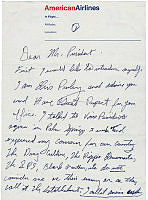Rubenstein Center Scholarship
Benjamin Latrobe Expresses Indignation About Dolley Madison's Servants

Benjamin Latrobe
Benjamin Henry Latrobe, Architect of the Capitol and Surveyor of Public Buildings under Jefferson, had advised the Madisons about changes to the White House even before they arrived in 1809.1 He continued to consult with Mrs. Madison about her household until about 1813.2
Latrobe once visited the White House in Mrs. Madison's absence, to make sure that the curtains had been laundered. He discovered that they had not, and demanded to know why. He wrote to Mrs. Madison that a housekeeper, Mrs. Swiney, "told me, that on attempting to obey me she was informed, that you are so displeased with my conduct . . . that you intended I should do nothing more for you. . . . As this information could only come from your servants, I ought to presume that it was false. . . .[It] would be an insult to you to suppose . . . that such intelligence would be conveyed to a man of character, . . . at second hand, by a servant."3
Dolley Madison replied, "I shall be strict in my examination of the servants, when I return, as I wish to know those, who have taken the liberty to mis-represent me."4
































































